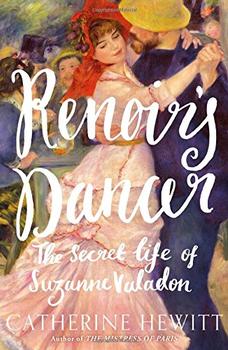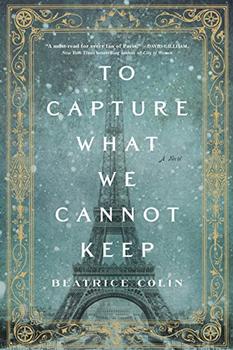Summary | Excerpt | Reading Guide | Reviews | Beyond the book | Read-Alikes | Genres & Themes | Author Bio

A documentary about the real-life model for Edgar Degas' famous sculpture, Little Dancer of Fourteen Years (La Petite Danseuse de Quatorze Ans), captured author Cathy Marie Buchanan's interest and set her on a course to bring the dancer's story to life.
 The Painted Girls is the result of Buchanan's meticulous research and it is a wonderful novel of historical fiction that is also a lovely tribute to a girl many would otherwise never know. Buchanan creates a vivid world – that of Paris during the early years of the Belle Époque (see 'Beyond the Book'). This era was a time of growth in art and literature. As well, the Industrial Revolution allowed for continued advances in science and technology. While the Belle Époque may conjure images of beauty, optimism and art, it also had a seedy underbelly. Buchanan does not shy away from showing readers this world, and what life was like for the less privileged - those from the slums and lower classes who did not have access to family wealth or good education. Juxtaposition really speaks to the heart of The Painted Girls. The fine lines between depravity and dignity, wealth and poverty, beauty and ugliness, truth and fiction are all taken on by Buchanan and woven together in a mesmerizing novel.
The Painted Girls is the result of Buchanan's meticulous research and it is a wonderful novel of historical fiction that is also a lovely tribute to a girl many would otherwise never know. Buchanan creates a vivid world – that of Paris during the early years of the Belle Époque (see 'Beyond the Book'). This era was a time of growth in art and literature. As well, the Industrial Revolution allowed for continued advances in science and technology. While the Belle Époque may conjure images of beauty, optimism and art, it also had a seedy underbelly. Buchanan does not shy away from showing readers this world, and what life was like for the less privileged - those from the slums and lower classes who did not have access to family wealth or good education. Juxtaposition really speaks to the heart of The Painted Girls. The fine lines between depravity and dignity, wealth and poverty, beauty and ugliness, truth and fiction are all taken on by Buchanan and woven together in a mesmerizing novel.
As the story begins, the van Goethem family is about to be evicted from their one-room tenement. Mrs. van Goethem is pleading for an extension on their rent, asking for some compassion as she is mourning the very recent death of her husband. The landlord reluctantly agrees to a short deferment. Mrs. van Goethem instructs her oldest daughter, Antoinette, to take her two younger sisters to the Paris Opera in the hopes of having them accepted to the ballet school. The ballet school trains girls with potential, offering them strict daily instructions, exams and advancement, while paying them to attend classes. Many families living in Parisian tenements view the ballet school as a way for daughters to escape their situations and have a chance at a better life. After successfully passing their entrance exams, Marie and Charlotte, the youngest daughters of the van Goethem family, are both invited to join the Paris Opera's ballet school and begin their studies and work as 'petits rats' ((little rats, a description still sometimes used to describe students of the Paris Opera Ballet School).
For her part, Mrs. van Goethem works as a washerwoman, earning a pittance. She develops an addiction to absinthe, which not only depletes her earnings but also effectively absents her from any role as a caring and nurturing mother. In this household, the sisters are left to take care of each other and rely only upon themselves. Centered on the two oldest sisters, Antoinette and Marie, The Painted Girls is a heartfelt story about the importance and strength of a sisterly relationship. Seventeen year-old Antoinette has not had much formal education and becomes increasingly street smart as she searches for employment. Marie, a very bright girl, had been favored by their father and encouraged in her scholarly studies. Though younger than Antoinette, Marie is a bit more refined. The differences in their speech and behaviors are nuanced but evident in the language they use and in their manners. Told in voices alternating between these two sisters, Buchanan's skills as a writer truly shine.
As the oldest, Antoinette feels the burden of responsibility for her two younger sisters acutely. She eventually lands a small role in a play, a controversial staging of L'Assommoir, a novel by Émile Zola. Through cast-mates, Antoinette is led down a path of dishonor. She is pulled, unknowingly into a murder mystery when her boyfriend, Émile Abadie, is accused and tried for murder. The relationship between the two sisters is strained and nearly broken as Marie fights against Antoinette's support of Émile.
Meanwhile, at the ballet school, it is discovered that Marie, though not a physically beautiful girl, has a surprising flexibility and instinctive feel for the music that makes her a dancer with huge potential and enviable natural skill. Artist Edgar Degas often watches the ballerinas in class and pays some of the girls to pose for him at his studio. Marie becomes his muse and visits him regularly, earning extra money for her family.
Through Degas, Marie also attracts the attention of Monsiuer Lefebvre, a season-ticket holder at the Paris Opera ballet. It was common for dancers to have patrons who helped with their expenses and, hopefully, their elevation through the ballet company. Lefebvre takes a shine to Marie and, again driven by the need for money, she accepts his offer of patronage. This was an unknown side of ballet to me and I was very surprised by the revelation that a high art form that is now viewed as full of grace and elegance, went through such a notorious era. These male patrons, for the most part, did not act altruistically or nobly. They preyed on young girls in a manner tacitly accepted by society.
William Shakespeare wrote "All the world's a stage, And all the men and women merely players." The Painted Girls gives the van Goethem girls a stage and they play roles necessary to survive and escape. Buchanan offers an unsentimental look at family and love during an era more noted for its glamour and optimism, wealth and excess. While the story can be heartbreaking at moments, Buchanan's beautiful prose gives this emotional read, hope. The reality of life off stage may be hard but despite where we are born, despite circumstances that seem designed to prevent us from rising, these hardships can be overcome.
Picture of sculpture by Frank Kovalchek from Wikipedia.org
You can watch the BBC documentary about Degas' famous sculpture, Little Dancer of Fourteen Years, by clicking on the video below:
![]() This review was originally published in The BookBrowse Review in March 2013, and has been updated for the
February 2014 edition.
Click here to go to this issue.
This review was originally published in The BookBrowse Review in March 2013, and has been updated for the
February 2014 edition.
Click here to go to this issue.

If you liked The Painted Girls, try these:

by Catherine Hewitt
Published 2018
Catherine Hewitt's richly told biography of Suzanne Valadon, the illegitimate daughter of a provincial linen maid who became famous as a model for the Impressionists and later as a painter in her own right.

To Capture What We Cannot Keep
by Beatrice Colin
Published 2017
Set against the construction of the Eiffel Tower, this novel charts the relationship between a young Scottish widow and a French engineer who, despite constraints of class and wealth, fall in love.
To make a library it takes two volumes and a fire. Two volumes and a fire, and interest. The interest alone will ...
Click Here to find out who said this, as well as discovering other famous literary quotes!
Your guide toexceptional books
BookBrowse seeks out and recommends the best in contemporary fiction and nonfiction—books that not only engage and entertain but also deepen our understanding of ourselves and the world around us.